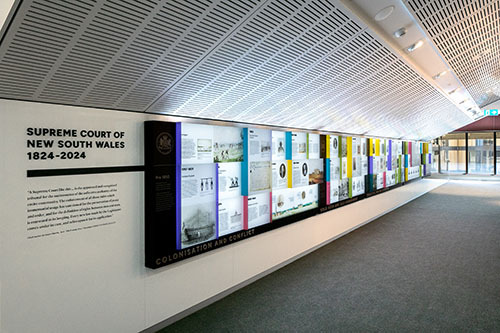- Winter 2024
- Sophie Howard: The woman behind the walls
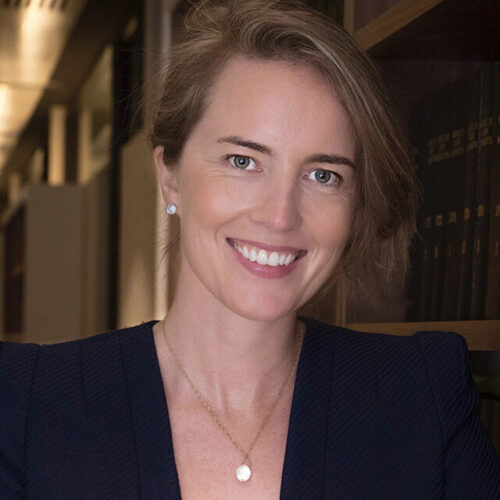
The bicentenary of the Supreme Court of New South Wales saw the installation of the Supreme Court Gallery and History Wall on level 13, close to the entrance of the Banco Court. Artist and creative Sophie Howard curated this significant project.
Identifying the person for the job must have tested the adage, ‘needle in a haystack’, especially given the curious job description to the effect of: ‘Project Officer – History Wall Exhibition’. But Sophie certainly fitted the bill. She has a special interest in art, history and society; her experience includes visual arts, theatre and film; and she holds a Bachelor of Fine Arts (Properties and Objects) from the National Institute of Dramatic Art (NIDA).
A major task for Sophie was to build the art collection, literally from scratch. On day one of her contract, not a single work had yet been identified for inclusion in the collection. That the court now has such a tremendous end product after just a year demonstrates how far-reaching and tenacious Sophie’s efforts have been.
The project has seen Sophie comb scores of archives and existing collections to identify suitable artworks and images for both the art gallery and the History Wall, as well as selecting the 500-plus images for the commemorative book, Constant Guardian, Changing Times: the Supreme Court of New South Wales 1824–2024, edited by Keith Mason AC KC and Larissa Reid.
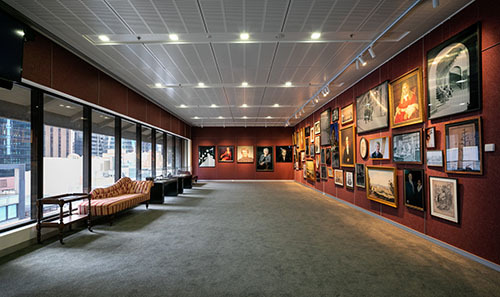
Art gallery
The northern wall features striking portraits of the first five female judges appointed to the Supreme Court of New South Wales. The portrait of the Hon Jane Matthews is a brilliant digital photo collage commissioned by Sydney artist Rocco Fazzari (who also created this issue’s cover). From a distance, it bears a close resemblance to the late female judge, but up close, viewers discover that the artwork comprises multiple headshots of women in the legal profession – a symbolic depiction for this trailblazing legend who laid the pathway for women in the legal profession in New South Wales. The portrait of Her Excellency the Hon Margaret Beazley, painted in oil by Adelaide artist Tsering Hannaford, was commissioned in 2021 and forms part of the collection of the Art Gallery of New South Wales. It is a beautiful portrait that depicts Her Excellency sitting in a crimson suit, looking powerful, yet poised and elegant.
The remaining three portraits – of the Hon Carolyn Simpson, the Hon Virginia Bell and the Hon Patricia Bergin – are photographic. The earliest, depicting the Hon Carolyn Simpson and shot by Kate Callas for Fairfax Media in 1994, is taken from an interesting angle: looking up to her Honour, who is leaning against the distinctive textured concrete of the court building with her sleeves rolled up and holding her glasses, perhaps pondering the future.
The eastern wall features 47 artworks comprising a mix of portraiture, drawings, lithographs, and colonial art and photography. With 200 years to cover in a distance of only about 25 metres, the art collection is naturally eclectic and yet still representative.
A remarkable work hangs on the far left of the eastern wall; it is an original painting made circa 1824 (artist unknown) that depicts Frederick Garling, the first appointed crown solicitor of the Supreme Court of New South Wales and later the deputy judge advocate appointed by Governor Macquarie. The painting was donated to the court by his fifth-generation descendants. Coincidentally, two other artworks in the collection (watercolours of Sydney Cove and Darlinghurst) were painted by his son, Frederick Garling Jr.
Although the collection predominantly comprises reprints, they are of very high quality. For example, the photography prints are produced on aluminium using ChromaLuxe technology and have an enchanting lustre. One photo portrait shows the legendary Aboriginal rights activist, Mum Shirl, standing outside the Redfern office of the then newly formed Aboriginal Legal Service, which she helped to establish. The oil painting reprints are printed on canvas. A significant oil portrait reprint, the original of which belongs to the National Portrait Gallery, depicts Sir William Charles Windeyer, painted in 1892 by the famous Australian artist, Tom Roberts.
One of the more whimsical works is an enlarged reprint of a postage stamp issued in 1974 by Australia Post to commemorate the 150th anniversary of Australia’s Third Charter of Justice. Other artworks depict the external and internal architecture of parts of the court at various times, including magnificent photographs taken by Max Dupain and Murray Harris.
Prior to the hanging, the display walls were gutted then reclad in a crimson hue, and gallery style lighting was installed. Sophie selected a salon hang to achieve a visual flow, rather than, for example, a thematic or chronological flow. She was ably assisted with the layout for the hang by their Honours Justices Kunc and Weinstein. Sophie also selected the frames for the artworks, which are in keeping with their individual style rather than pursuing homogeneity across the collection.
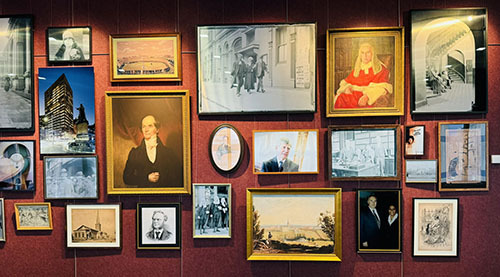
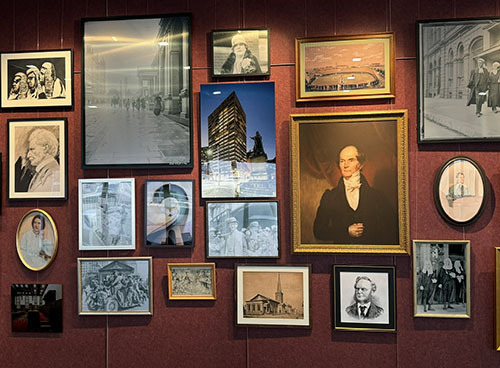

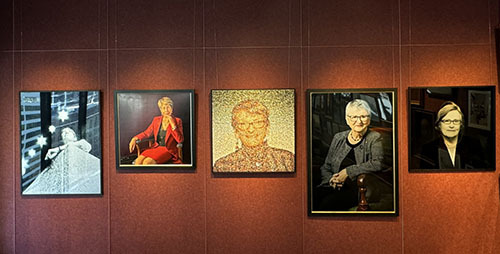
History Wall
The History Wall, located on the southern wall adjacent to the entry to the Banco Court, comprises 50 illuminated boxes that contain various chapters of the court’s 200-year history. The five main themes are ‘Colonisation & Conflict (pre-1850)’, ‘Gold Rush & Self-Government (1851–1900)’, ‘Federation, War & Depression (1901–1945)’, ‘Post-War Change (1946–1998)’ and ‘Globalisation & Disruption (1999–2024)’. Within each theme, various other topics are explored. For example, ‘Post-War Change’ includes the opening of the new court at Queen’s Square in 1977; a charming photo shows the judges in ceremonial attire walking across Queens Square next to a grey Volkswagen Kombi van, which was the radio news vehicle.
Sophie designed the look of the History Wall in close collaboration with the court’s media manager, Chris Winslow, who has had a long association with the NSW Bar Association. The LED box concept was produced by the design company, XSquaredDesign.
Capturing 200 years of the Supreme Court’s history, particularly such a changing history, was a challenge, but Sophie says she adopted a humanist tone in order to reflect the court in a time of societal change.
